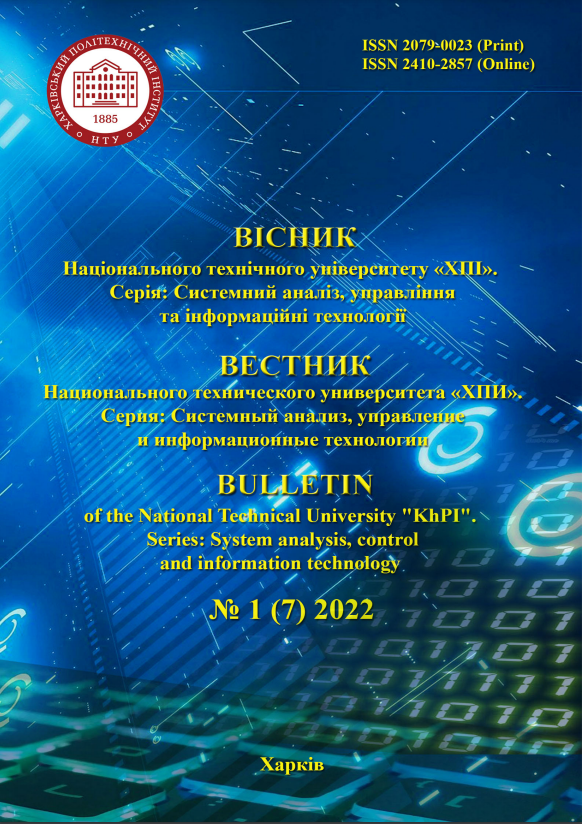STUDY OF THE INFLUENCE OF THE QUALITY OF ASSIMILATION OF THE PREVIOUS MATERIAL ON THE PREDICTION OF STUDENT GRADES IN A PARTICULAR DISCIPLINE
DOI:
https://doi.org/10.20998/2079-0023.2022.01.12Keywords:
educational and professional program, structural logic diagram, forecasting, artificial neural network, perceptron, sigmoid, neural network training, unified modeling language, information model, decision support systemAbstract
The paper considers the basic concepts related to the quality of education in general and the assimilation of students of educational material. The problem of predicting a student's grade in any discipline is formulated, having grades in "providing" disciplines. A list of methods that can be applied to solve the problem (multivariate regression analysis method, artificial neural networks method, k nearest neighbors method) is presented, a conclusion is made about the expediency of using the artificial neural networks method. The formulation of the problem of predicting the assimilation of knowledge and programming skills is described. The architecture used was a perceptron with four input neurons, one output neuron, and 10 hidden layer neurons. By conducting a series of numerical experiments, the optimal architecture of the neural network was selected. As an example, the curriculum and the structural and logical scheme of the educational and professional program "Intelligent Decision Making Systems" of the specialty 124 "System Analysis" were used. The created information model of the designed system is described in the visual modeling language UML (diagrams of use cases, classes, cooperation, sequence, states, activities and components). The possibilities of the system for studying the influence of the assimilation of the previous material on the prediction of students' grades in a particular discipline are described, an example of the functioning of this system is given, and an analysis of the results of calculations is carried out. It is indicated that the system allows analysis of the results of calculations for further selection of the best method for forecasting.
References
Polozhennja pro vnutrishnju systemu zabezpechennja jakosti osvity [Regulations on the internal system for ensuring the quality of education]. URL: http://www.dgma.donetsk.ua/docs/acts/ Положення_про_внутр_сист_заб_якості_ДДМА_2020_Сайт.pdf. (accessed 21.11.2021).
Osvitn'o-profesijna programa «Intelektual'ni systemy pryjnjattja rishen'» pershogo rivnja vyshhoi' osvity za special'nistju № 124 «Systemnyj analiz» galuzi znan' № 12 «Informacijni tehnologii'». [Educational and professional program "Intelligent Decision Making Systems" of the first level of higher education in the specialty No. 124 "System Analysis" of the branch of knowledge No. 12 "Information Technologies"]. URL: http://www.dgma.donetsk.ua/docs/kafedry/ispr/opp/ Системний_аналіз_бакалавр.pdf (accessed 21.11.2021).
Melnykov O. Ju., Bobryk A. V. Postanovka zadachi doslidzhennja vplyvu jakosti zasvojennja poperedn'ogo materialu na prognozuvannja ocinok studentiv z okremoi' dyscypliny. [Statement of the problem of studying the influence of the quality of assimilation of the previous material on the prediction of students' grades in a particular discipline]. Suchasna osvita – dostupnist', jakist', vyznannja: zbirnyk naukovyh prac' XIII Mizhnarodnoi' naukovo-metodychnoi' konferencii', 16–18 lystopada 2021 roku. [Proc. of the Int. Conf. "Modern education - accessibility, quality, recognition"]. Kramators'k, DDMA Publ., 2021, pp. 199–201.
Melnykov O. Ju. Ob’jektno-orijentovanyj analiz i projektuvannja informacijnyh system: posibnyk dlja studentiv special'nostej «Systemnyj analiz» ta «Informacijni systemy ta tehnologii'». Vyd. 3- je, pererob. ta dop. [Object-oriented analysis and design of information systems: a manual for students of the specialties "System Analysis" and "Information Systems and Technologies"]. Kramators'k, DDMA Publ., 2020. 208 p.
Deductor – prodvinutaja analitika bez programmirovanija [Deductor – advanced analytics without programming]. URL: https://basegroup.ru/deductor/description (accessed 21.11.2021).
Melnykov O. Ju. Prognozuvannja ocinok studentiv z okremoi' dyscypliny zalezhno vid jakosti zasvojennja poperedn'ogo materialu. [Prediction of students' grades in a separate discipline, depending on the quality of mastering the previous material]. Suchasni informacijni tehnologii', zasoby avtomatyzacii' ta elektropryvod: materialy V Vseukrai'ns'koi' naukovo-tehnichnoi' konferencii'. [Proc. of the Int. Conf. "Modern information technologies, automation equipment and electric drive"]. Kramators'k, DDMA Publ., 2021, pp. 297–300. http://dspace.dgma.donetsk.ua/handle/DSEA/802 (accessed 21.11.2021).
Galushkyn A. Y. Nejrokomp'juteri. Kn.3: Uchebnoe posobye dlja vuzov. [Neurocomputers]. Moscow, YPRZhR Publ., 2000. 528 p.
Widrow B., Lehr M. A. 30 years of adaptive neural networks: perceptron, madaline and backpropagation. Proceedings of the IEEE. 1990, vol. 78, №. 9, pp. 1415–1442.
Gorban' A. N. at al. Nejroinformatika. [Neuroinformatics]. Novosibirsk, Nauka, Sibirskaja izdatel'skaja firma RAN Publ., 1998. 296 p.
Mirkes E. M. Nejroinformatika: ucheb. posob. [Neuroinformatics]. Krasnojarsk, KGTU Publ., 2002. 120 p.
Gitis V. B. Nejromerezhni tehnologii': navchal'nyj posibnyk. [Neural network technologies]. Kramators'k, DDMA Publ., 2021. 248 p.
Wynne-Jones M. Node splitting: A constructive algorithm for feedforward neural networks. Neural Computing and Applications. 1993, vol. 1, №. 1, pp. 17–22.
Melnikov A. Ju. Prognozirovanie izmenenija vklada prepodavatelja v rabotu kafedry i ispol'zovaniem metodov intellektual'nogo analiza dannyh. [Predicting the change in the teacher's contribution to the work of the department and the use of data mining methods]. Informacionnye tehnologii i sredstva obuchenija. [Information technology and learning tools]. 2018, № 1 (63), pp. 266–287.
Downloads
Published
How to Cite
Issue
Section
License
LicenseAuthors who publish with this journal agree to the following terms:
- Authors retain copyright and grant the journal right of first publication with the work simultaneously licensed under a Creative Commons Attribution License that allows others to share the work with an acknowledgement of the work's authorship and initial publication in this journal.
- Authors are able to enter into separate, additional contractual arrangements for the non-exclusive distribution of the journal's published version of the work (e.g., post it to an institutional repository or publish it in a book), with an acknowledgement of its initial publication in this journal.
- Authors are permitted and encouraged to post their work online (e.g., in institutional repositories or on their website) prior to and during the submission process, as it can lead to productive exchanges, as well as earlier and greater citation of published work (See The Effect of Open Access).


